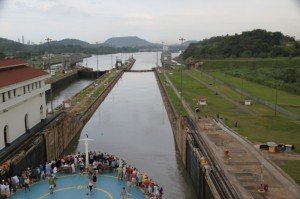
(Scoop San Diego) The enduring ability to inspire wonder and awe, and to weather the rigors of time, Mother Nature and human politics – these are the qualities that elevate an engineering feat to landmark status. These attributes have drawn millions to the Great Pyramids of Giza, the Great Wall of China and the Eiffel Tower over the centuries. In 2014, admiring eyes will surely turn to Central America, as the year marks the 100th anniversary of the Panama Canal.
As engineering feats go, the canal is likely to amaze travelers for centuries to come. The 48-mile-long man-made waterway connects the Caribbean Sea in the Atlantic Ocean to the Pacific Ocean at the narrowest point on the Central American isthmus. First conceived as a way to help ships avoid the dangerous passage around Cape Horn at the southern-most tip of South America, the canal opened for business in 1914. The Panama Canal cut in half ships’ travel time from the Atlantic to Pacific oceans.
Nearly a million ships have traversed the canal in the past 100 years, including cruise ships bearing travelers who come to experience the one-of-a-kind passage. Touring the Panama Canal and Central America allows travelers to not only see this modern engineering wonder, it provides access to beautiful landscapes, amazing wildlife and centuries-old cultures.
Many people find an all-inclusive trip, like Tauck’s Panama Canal & Costa Rica cruise, makes it easy to experience all the region has to offer. The 11-day itinerary includes over-night stays in both Panama City and San Jose, and a six-night cruise aboard a newly renovated, 88-passenger yacht that transits through the Panama Canal. Expert naturalists guide guests on explorations of the lush Central American interior and its abundant wildlife.
Swimming, snorkeling and museum-hopping can all be on your agenda, and you can even visit a coffee plantation to learn how coffee beans are grown, harvested and brewed. With 88 years in the tourism industry, Tauck has been delighting travelers for nearly as long as the Panama Canal has.
Near historic San Jose, travelers can explore a rainforest eco-park where they may see toucans, spider monkeys and red-eyed leaf frogs. After two days of fun in the sun on Osa Peninsula and Coiba Island, Tauck guests begin their passage through the Panama Canal, starting on the Pacific side of the waterway.
Because sea level on the opposite ends of the canal varies by 85 feet, the Panama Canal designers created a series of locks to lift and lower ships as they move through the channel. In the early days of the canal, mules towed ships through the locks, and today the mechanical tractors that do the job are still called “mules” in honor of the four-legged workers. Commentary from a local expert helps put the wonder of the canal in perspective, whether your passage occurs in daylight or by moonlight.
To learn more about a Costa Rica and Panama Canal tour, visit Tauck.com.